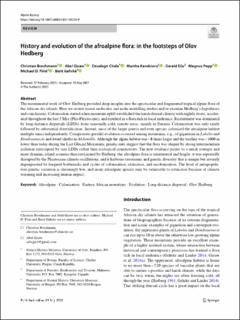| dc.description.abstract | The monumental work of Olov Hedberg provided deep insights into the spectacular and fragmented tropical alpine flora of the African sky islands. Here we review recent molecular and niche modelling studies and re-examine Hedberg’s hypotheses and conclusions. Colonisation started when mountain uplift established the harsh diurnal climate with nightly frosts, accelerated throughout the last 5 Myr (Plio-Pleistocene), and resulted in a flora rich in local endemics. Recruitment was dominated by long-distance dispersals (LDDs) from seasonally cold, remote areas, mainly in Eurasia. Colonisation was only rarely followed by substantial diversification. Instead, most of the larger genera and even species colonised the afroalpine habitat multiple times independently. Conspicuous parallel evolution occurred among mountains, e.g., of gigantism in Lobelia and Dendrosenecio and dwarf shrubs in Alchemilla. Although the alpine habitat was ~ 8 times larger and the treeline was ~ 1000 m lower than today during the Last Glacial Maximum, genetic data suggest that the flora was shaped by strong intermountain isolation interrupted by rare LDDs rather than ecological connectivity. The new evidence points to a much younger and more dynamic island scenario than envisioned by Hedberg: the afroalpine flora is unsaturated and fragile, it was repeatedly disrupted by the Pleistocene climate oscillations, and it harbours taxonomic and genetic diversity that is unique but severely depauperated by frequent bottlenecks and cycles of colonisation, extinction, and recolonisation. The level of intrapopulation genetic variation is alarmingly low, and many afroalpine species may be vulnerable to extinction because of climate warming and increasing human impact. | en_US |

